


Christmas Store
The holidays are just around the corner so now is the time to fetch the finest gifts for the Labrador Lover on your Christmas list. We have over 100 gifts $50.00 and under. Visit our Christmas Store.
For the Lab
Bedding
Coats
Collars and Leads
Dog Bowls
Feeding Stations
Spa and Grooming
Toys and Treats
Travel and Accessories
For the Lab Lover
Apparel
Cards and Giftwrap
Fine Accessories
Gifts and All Occasions
Jewelry
Kids Only
For the Lab Home
Artwork
Books
Garden and Outdoor
Home Furnishings
Kitchen Accessories
Pillows, Throws, and Rugs
Gift ServicesGift Boxes
Gift Certificates
Lymes, Rocky Mountain Spotted Fever, Ehrlichia
The tick season is here and so is tick disease season. This is a subject near and dear to my heart as my current Wilderness Search and Rescue dog was severely affected by Rocky Mountain Spotted Fever (RMSF) last summer. Here is an overview of the three main tick borne diseases: Lyme Disease, Rocky Mountain Spotted Fever, and Ehrlichia and steps on how to protect your Lab during tick season.
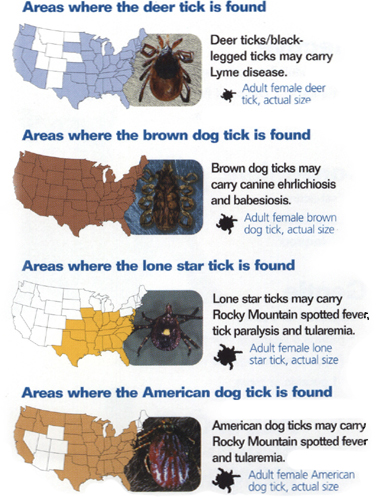
The tick season is fast upon us and so is the tick disease season. This is a subject near to my heart as my current Wilderness Search and Rescue dog was severely affected by Rocky Mountain Spotted Fever (RMSF) last summer. Here is an overview of the three main tick borne diseases: Lyme Disease, Rocky Mountain Spotted Fever, and Ehrlichia.
Lyme Disease
Lyme disease seems to be the most common of all the tick diseases. In my practice in Virginia, about one-third of all the dogs tested are positive for Lyme disease. The most common clinical signs of an active Lyme infection are fever, decreased appetite and multiple swollen and painful joints. Interestingly, when a dog develops an acute infection, the joints that are most often affected are the ones closest to the tick bite. However, the lameness associated with Lyme disease can also be sporadic, and can alternate from one limb to another. These clinical signs can take 2-5 months to develop after an infected tick bites your dog. The infection can become subclinical and no clinical signs are evident. There is also a rare and nearly always fatal form of Lyme disease that attacks the kidneys. An interesting study showed that Labrador and Golden Retrievers were five times more likely to develop the kidney form of the disease than the general canine population.
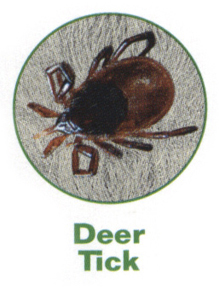
Lyme disease is transmitted by the deer or black legged tick with the deer mouse being the reservoir of the disease. These ticks are found in nearly every state. At this time, the disease is most prevalent in the east and north east and it’s been shown that more than 50% of adult deer ticks in this area carry Borrelia burgdorferi, the causative agent of Lyme disease. The good news is that it takes 24-48 hours after the tick becomes attached for B. burgdorferi to be transferred from the tick to the dog.
Rocky Mountain Spotted Fever
Rocky Mountain Spotted Fever (RMSF) is not as common as Lyme disease, but it usually causes a more significant illness and is more likely to be fatal. Eight to ten days after the bite of an infected tick clinical signs develop. Some of the clinical signs can mimic Lyme disease such as fever (up to 105°F), decreased appetite and generalized pain. In severe cases though, bleeding disorders causing unexplained bruising on the gums and in the skin and neurological signs such as in-coordination, head tilt and seizures can develop. My dog started with a fever, decreased appetite and generalized pain, but very quickly progressed to the neurological signs even while he was on antibiotics. It takes five to ten days after the bite of an infected tick for clinical signs to develop.
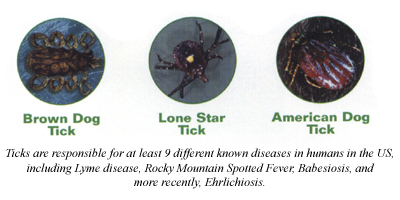
RMSF is transmitted by the American dog tick. These can be easily identified by the white saddle just behind the mouth parts. Again, these ticks are found just about everywhere. The good news is only 1-3% of ticks carry the disease causing organism. As with Lyme’s disease it takes an extended time after the tick attaches before transfer of the disease causing organism occurs, usually 6-20 hours.
Ehrlichia
Ehrlichia is another tick borne disease that can mimic other diseases and be hard to diagnose. There are several species of Ehrlichia that can cause disease: Ehrlichia canis, Ehrlichia chaffeensis, Ehrlichia ewingii, Ehrlichia equi, and Ehrlichia platys. The clinical signs of the acute phase are very vague: fever, lethargy, decreased appetite, and enlarged lymph nodes. After the bite of an infected tick, it takes one to three weeks for clinical signs to develop and then the signs may last only a week or two. The dog may then mount an immune response and clear the disease or it may subside into a sub clinical or chronic form. Again, the signs of a chronic infection are vague: weak, thin dog with no appetite and pale mucus membranes. In the chronic stage the bone marrow wears out and the dog develops a pancytopenia, meaning that there are no red blood cells, no white blood cells and no platelets being produced. Once this chronic stage is reached, prognosis is very guarded. An interesting fact: German Shepherds are more likely to develop the chronic form.
Ehrlichia is transmitted by several different kinds of ticks, the main vector being the brown dog tick and the other, minor vector being the Lone star tick. The brown dog tick is found in every state of the contiguous United States and the Lone star tick is found in the southeast. Most cases of ehrlichia are diagnosed in the spring and summer months when the ticks are most active.
Diagnosis
It can be very difficult to unequivocally diagnose a tick disease because there are so many variables that affect the course of the disease: age of the dog, health of the dog and the ability of the dog’s immune system to mount a response are just a few. Sometimes it is very easy to diagnose- young active dog that hikes, suddenly shifting leg lameness with high fever makes me think of tick disease. But, this also mimics trauma, early hip or elbow dysplasia, OCD and panosteitis.
You should think of four things when considering a tick borne disease:
- History of exposure to ticks
- Clinical signs typical for the disease
- Specific antibodies to the individual disease
- Good response to the antibiotic treatment
Let me explain a little about tick titers, because they can be very confusing. Titers in general, measure the antibody response to a disease. Most veterinarians have an in-house test for Ehrlichia canis only and Lyme. This is a very good screening test, but there is no quantitative value and in order to know if there is an active disease process you need to know what the titer is to the individual disease. The titer is given as a ratio: 1:64, 1:128, etc. If your dog is in the early stage of the infection, the titer may actually show no exposure (<1:20) or a very low exposure (1:64 or 1:128). If there are clinical signs evident that scream tick disease and the titer for your dog shows no exposure, it just means that the immune system hasn’t had a chance to mount a measurable response. Take a titer 2-4 weeks later and the titer should be at least four times greater than the original level.
My dog had a titer at the beginning of his bout with RMSF of 1:1024; that level, his clinical signs, and his response to doxycycline unequivocally said that he was suffering from RMSF. On a whim, 3 months later, I decided to recheck his RMSF titer. At that time it was 1:8192. He wasn’t still suffering from the disease, but his immune system had mounted one heck of a response. Interestingly, his titer for Lyme’s remained positive, but levels stayed the same (1:256) which probably meant that he’d been exposed and developed an immune response to control the infection. One thing to keep in mind, don’t wait for the paired titer to be run, start treating for the tick disease right away if the suspicion for it is high. Doxycycline is inexpensive with relatively few side effects, but the tick diseases are horribly debilitating and can cause long term effects if not treated early.
It is when these diseases become chronic that they can be very hard to diagnose. Titers don’t usually change dramatically as they do when in the active stage, so a rising titer can’t always be helpful for the diagnosis. You need to work closely with your veterinarian to help figure out if a chronic tick disease is the problem.
Treatment
Treatment of choice for all tick diseases is doxycycline, daily for at least 4 weeks. Most of the agents that cause these problems are slow growing and it takes this long for the antibiotic to be effective. If the dog is very sick from the disease, hospitalization is needed, but most can be treated on an out-patient basis. The response to doxycycline is startling. Most times the dog will appear completely normal 24 hours after starting the medication.
Prevention
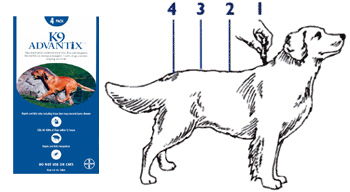
The only way to truly prevent these diseases is to kill the tick before it attaches. The good thing is that it takes many hours and sometimes days after attachment for the tick to transmit the disease. So, they need to be killed before that happens. The only products that I know for sure that repels ticks before they attach are: the Preventic™ collar and Advantix™. The main draw back with the Preventic™ collar is it can’t get wet or its effectiveness is severely reduced. Another significant problem is that it is extremely toxic if the dog happens to get the collar off and chews on it. Advantix™ is relatively new and according to the manufacturer, will actually repel the ticks and kill them before they can attach. It is supposed to repel mosquitoes as well and is water resistant. Frontline™ is another product that I recommend to my clients, it doesn’t repel the ticks, but it does eventually kill them. It too, is water resistant. There is currently a Lyme disease vaccine available for dogs. However, there are varying opinions on its effectiveness. Your veterinarian can tell you if this precaution is a good idea for your area.
Do a thorough tick check each night, after working your dog in tick habitats. That is most likely going to be the best way to prevent that nasty arthropod from attaching and making your partner sick.
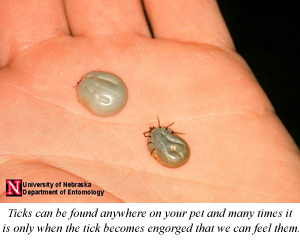
How to Remove a Tick
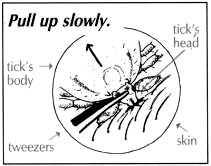
Because it takes roughly 24-48 hours for a tick to transmit bacteria, it is important to remove ticks from your pet’s skin as soon as you discover them. Do not attempt to remove the tick by touching it with a burnt match or swabbing it with alcohol or petroleum jelly. This will only aggravate the tick and cause it to release more bacteria into the blood. Do not kill the tick before it has been removed.
- Use either a tick removing device or a pair of fine-tipped tweezers.
- Do not squeeze the ticks body, but rather, grasp the mouthparts of the tick as close to the skin as possible.
- Pull the tick straight out with a firm and steady force until it releases its hold. Do not twist the tick as you are pulling.
- The barbed mouth of a tick will not let go easily, so take your time and be patient- you want to get the whole tick.
- If it is a female tick, there will be eggs inside, so you want to get rid of them in a safe manner. This can be achieved by placing the tick in a jar of rubbing alcohol. (Your veterinarian may also want to identify it.) Ticks are not killed by flushing them down the toilet. Please do not squash the tick with your fingers. The contents of the tick can transmit disease.
- Wash the area of the bite thoroughly with soap and water. You may also want to, apply a small amount of a triple antibiotic ointment.
- Watch the bite for signs of inflammation. It is not uncommon for a welt and skin reaction to occur. The swelling is due to toxic tick saliva.
 Can You Spot The Holiday Hazards?
Can You Spot The Holiday Hazards?It’s easy for pets, especially Labradors, to get into trouble during the holidays. You may get so busy that you lose track of what is going on with your dog.
Click here to learn more about: "Can You Spot The Holiday Hazards?"

Would you like to see your Lab pictured here? Send us images of your Lab and we may include them on our Home Page!
Labrador Links
The Verstaile Lab
History of the Lab
Advice
Travel
Featured Labs
Featured Artists
.jpg)

